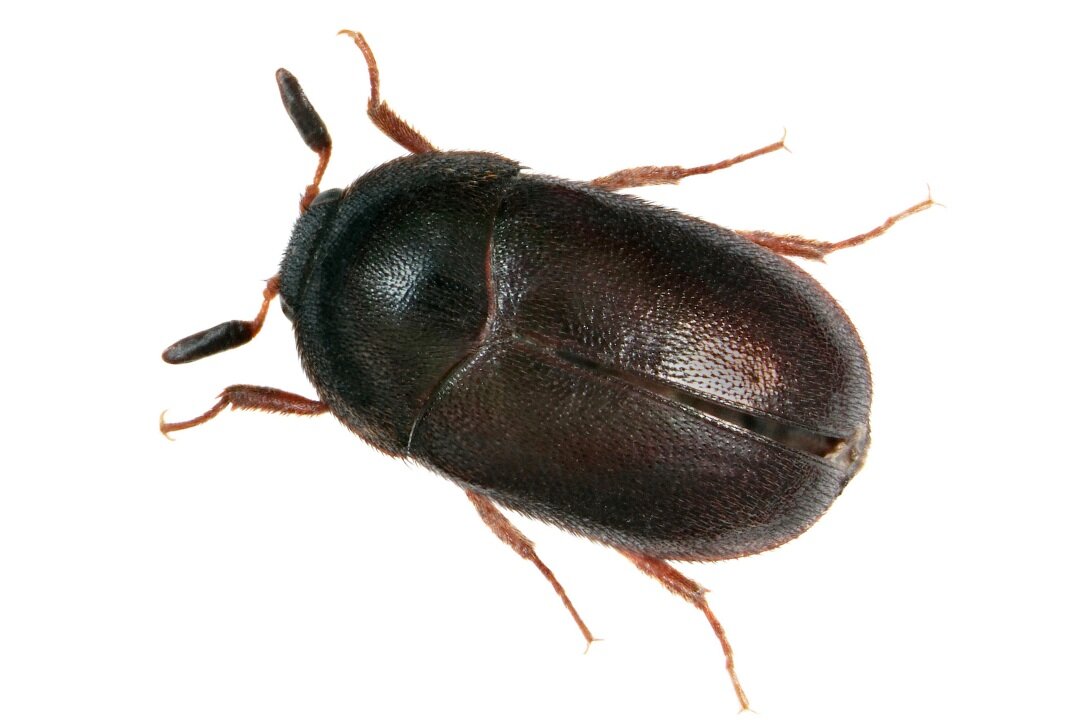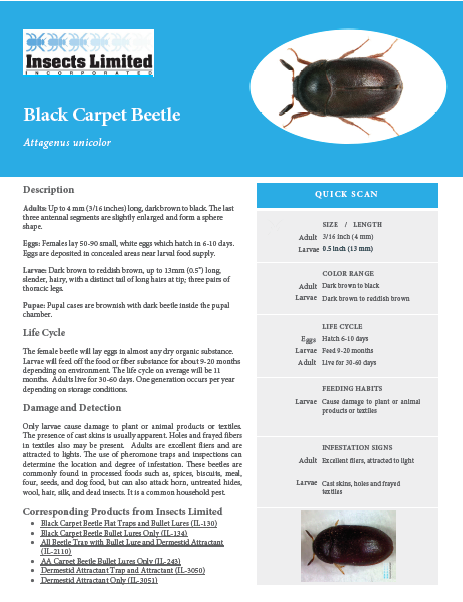Black Carpet Beetle (Attagenus unicolor)
Pheromone Traps for the Black Carpet Beetle
Black Carpet Beetle Description
Black Carpet Beetle Adults: Up to 4 mm (3/16 inches) long, dark brown to black. The last three antennal segments are slightly enlarged and form a sphere shape.
Black Carpet Beetle Eggs: Females lay 50-90 small, white eggs which hatch in 6-10 days. Eggs are deposited in concealed areas near larval food supply.
Black Carpet Beetle Larvae: Dark brown to reddish brown, up to 13mm (0.5") long, slender, hairy, with a distinct tail of long hairs at tip; three pairs of thoracic legs.
Black Carpet Beetle Pupae: Pupal cases are brownish with dark beetles inside the pupal chamber.
Black Carpet Beetle Life Cycle
The female black carpet beetle will lay eggs in almost any dry organic substance. Larvae will feed off the food or fiber substance for about 9-20 months depending on the environment. The life cycle on average will be 11 months. Adults live for 30-60 days. One generation occurs per year depending on storage conditions.
Damage & Detection
Only larvae cause damage to plant or animal products or textiles. The presence of cast skins is usually apparent. Holes and frayed fibers in textiles also may be present.
Adult black carpet beetles are excellent fliers and are attracted to lights. The use of pheromone traps and inspections can determine the location and degree of infestation.
These beetles are commonly found in processed foods such as, spices, biscuits, meal, four, seeds, and dog food, but can also attack horn, untreated hides, wool, hair, silk, and dead insects. The black carpet beetle is a common household pest.
Fun Facts about Black Carpet Beetle
Commonly confused with other Anthrenus, Anthrenocerus, and Trogoderma species.
Black carpet beetles initiate flight at temperatures above 22.5°C (73°F).
Black carpet beetle larvae have hairs on their body called setae that can cause gastrointestinal irritation in infants, children, and at-risk individuals. They may also cause an allergic reaction.
Adult black carpet beetles feed on pollen and nectar of flowering plants.
Monitoring Tips & Tricks
Black Carpet Beetle Monitoring Guidelines
Lure
BULLET LURE® contains sex pheromone to attract male beetles. Effective duration of attraction is 90 days.
AA Carpet Beetle Lure contains sex pheromone to attract male beetles for both Varied Carpet Beetles and Black Carpet Beetles. Effective duration of attraction is 90 days.
Dermestid Larval Attractant contains a food attractant effectively attractive to both male and female Black Carpet Beetles as well as the larval stage of the same insect. Dermestid Larval Attractant can be stored in any temperature and has an effective attractiveness if the pellet maintains its structure and has not gotten wet.
Lure Storage
Keep Bullet Lures in unopened foil pouches in cool storage (less than 60° F) or place in the freezer for extended storage. Lures can remain frozen for up to 24 months or at room temperature for 12 months to retain their full effectiveness for use afterwards.
It is a best practice to keep the Dermestid Larval Attractant in cool storage (less than 60° F) or in a freezer for extended storage to protect from moisture and condensation. However, this practice is not required.
Trap Designs Used with Lure and Attractants
FLAT TRAPS are low profile flat rectangular sticky traps that can be placed on level surfaces.
THE ALL BEETLE TRAP is a low profile, 3 piece trap with a clear lid that should be placed on level surfaces.
DERMESTID LARVAL ATTRACTANT traps are the size of a business card with circular, ½ inch (12mm) cartridges attached to contain the Dermestid Larval Attractant. These devices are not designed to capture and hold the larvae with sticky glues and should be used to discover if a target pest is feeding on the attractant.
Black Carpet Beetle Pheromone Traps
Black Carpet Beetle Trap Placement & Use
Trap Placement Techniques
Pheromone traps can be placed out year-round but are especially recommended during warmer months when temperatures exceed 12.5°C (55°F). Floor pheromone traps like the All Beetle Trap and Flat Trap are more effective at capturing Black Carpet Beetles. Place one or two pheromone traps per room.
In commercial areas such as warehouses or museums, place pheromone traps 7.5–15 m (25–50 feet) apart to determine the presence or absence of Black carpet beetles. Increase pheromone trap density to 4.5–7.5 m (15–25 feet) apart to help locate the source of black carpet beetle.
Keep pheromone traps 7.5 m (25 feet) away from exterior doors. Black carpet beetle pheromone traps are best utilized in areas that store items that contain natural fibers and stored foods such as wool, hair, feathers, furs, upholstered furniture (containing natural wools and leathers), food, grains, seeds, spices, nuts, dried fruit, animal feed, or pet food.
Trap and Lure Maintenance
Replace pheromone traps when glue is filled with insects or becomes dusty. Replace pheromone lures every 90 days. Replace all pheromone lures in a location at the same time. Do not cut the cap off the bullet lure. Do not stagger lure replacement over several weeks. Record date and number of catches to identify trending information.
Black Carpet Beetle FAQs
How do you get rid of Black Carpet Beetles?
Once an infestation of carpet beetles has become established, the first step in getting rid of them is to figure out where they are coming from and then removing or treating that object. This is best done using a combination of pheromone and food attractant in a monitoring trap. Greater numbers of beetle adults or larvae in a trap will indicate that you are close to an infestation.
The greater the number of carpet beetles in the trap, the closer you are to the source of the infestation. It eventually comes down to a detailed visual inspection of the area around the traps with the highest activity to find the source. With Carpet Beetles, it could be a wool rug or carpet, it could also be fur, hair, feathers, skin or any other animal based fibers.
Once you locate the source, it is best to bag it up if it is small enough. This includes individual articles or clothing or smaller ethnographic objects like turtle shells, etc. Then those objects can be safely disposed of in an external trash bin or it can be frozen for one week to kill all stages of the beetles. On large items such as furniture, taxidermy or rugs, steam cleaning or freezing with nitrogen will kill insects on the surface.
Chemical treatments on rugs should be avoided, but if it appears as the only option, they will need to be determined on a case by case basis based on how safe they are to the people and pets that come in contact with the rugs.
What causes carpet beetle infestations?
Carpet beetles feed on natural animal fibers in nature. This includes fur, hair, feathers, skin or any other animal based fibers. They serve an important service in breaking down the carcasses of animals and birds that die naturally or are hit by cars or other means of human interaction.
Many types of clothing such as wool sweaters, fur coats, hats containing feathers are often the target of carpet beetles. Taxidermy and wool rugs (Persian or other) are also commonly attacked and damaged by carpet beetles.
Many times, carpet beetles can enter a home in the spring or summer after they pick up odors coming from the house. Females that have already mated outdoors will lay their eggs on suitable food sources inside the house or business. Other times, the beetles can be brought into a home or business on used or antique rugs, taxidermy or clothing that has been purchased from a third party.
How do I know if I have Carpet Beetles?
The presence of the cast skins from the larvae is easily seen. Holes and frayed fibers in textiles also may be present.
Adults are excellent fliers and are attracted to lights. The use of pheromone traps and inspections can determine the location and degree of infestation.
These beetles are commonly found in nests of bees, wasps, and birds, but can also attack, horn, wool, hair, silk, dead insects and are occasionally found in meal, spices, and biscuits. It is a common household pest.
Join Our Informed Community
Receive the latest industry updates as soon as they are published.






